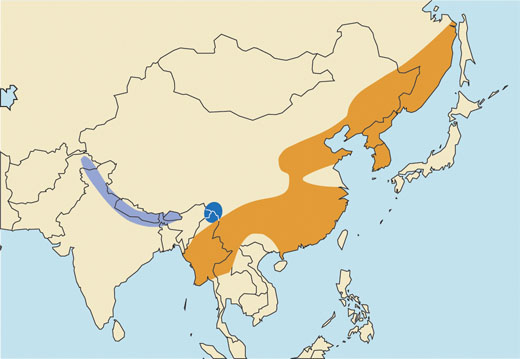 |
 |
Naemorhedus goral
Goral del Himalaya (Sp), Himalaya Goral (G), Goral de l'Himalaya (F). "Goral" is its local name in western Kashmir.
DESCRIPTION & TAXONOMIC NOTES Shoulder height 23-28 inches (58-71 cm). Weight 48-77 pounds (22-35 kg).
Somewhat resembles a serow, differing by its smaller size, shorter horns, lack of facial glands, and certain details of the skull. Stocky and goatlike in build, with strong, stout legs, a somewhat arched back and a concave facial profile. The hair is coarse and shaggy, overlying a short, woolly undercoat. In males, there is a slight crest of hairs along the back of the neck. The tail is short and bushy. Both sexes grow horns of similar length, but the female's are thinner.
Groves & Grubb (1985) recognize two subspecies, and use different nomenclature from that used by earlier authorities. The west Himalayan or gray goral (N. g. bedfordi-formerly named N. g. goral) of the western Himalayas is a buffy gray suffused with blackish above, and paler below. There is a white throat patch that extends to the cheeks, a dark streak on the muzzle, and no distinct dorsal stripe. Base of tail and knees are blackish, with the rest of the legs fawn. The horns are more curved and have heavier rings than those of the east Himalayan goral.
The east Himalayan or brown goral (N. g. goral, including hodgsoni-formerly named N. g. hodgsoni) of the eastern Himalayas is rufous-brown above and paler below, with a white patch on throat and chin, a black dorsal stripe and tail, and a black stripe down the front of the legs. The horns are comparatively straight and not heavily ringed. We do not separate the subspecies for record-keeping.
BEHAVIOR Lives in family groups of 4-12, although older males are usually solitary. Breeds in November or December, with 1-2 young born after 6-8 months. Sexual maturity is attained at age three. Captives have lived over 17 years.
Active early morning and late evening, or throughout the day when it is cloudy. Rests during the middle part of sunny days, lying motionless and blending with the surroundings. Diet includes grasses, shrubs, twigs and nuts. Requires water. Vision is acute, hearing good. Alarm call is a hissing or sneezing sound.
HABITAT Steep, rugged, forested mountains at elevations of 3,000-9,000 feet (900-2,700 m). Seems to prefer the most difficult terrain possible.
DISTRIBUTION The southern side of the Himalayan Range from Kashmir and Punjab eastward to Bhutan.
STATUS Listed as endangered by the USF&WS (1976) and on Appendix I of CITES (1975). Protected by law in India. It is quite plentiful, however, in Nepal.
|





